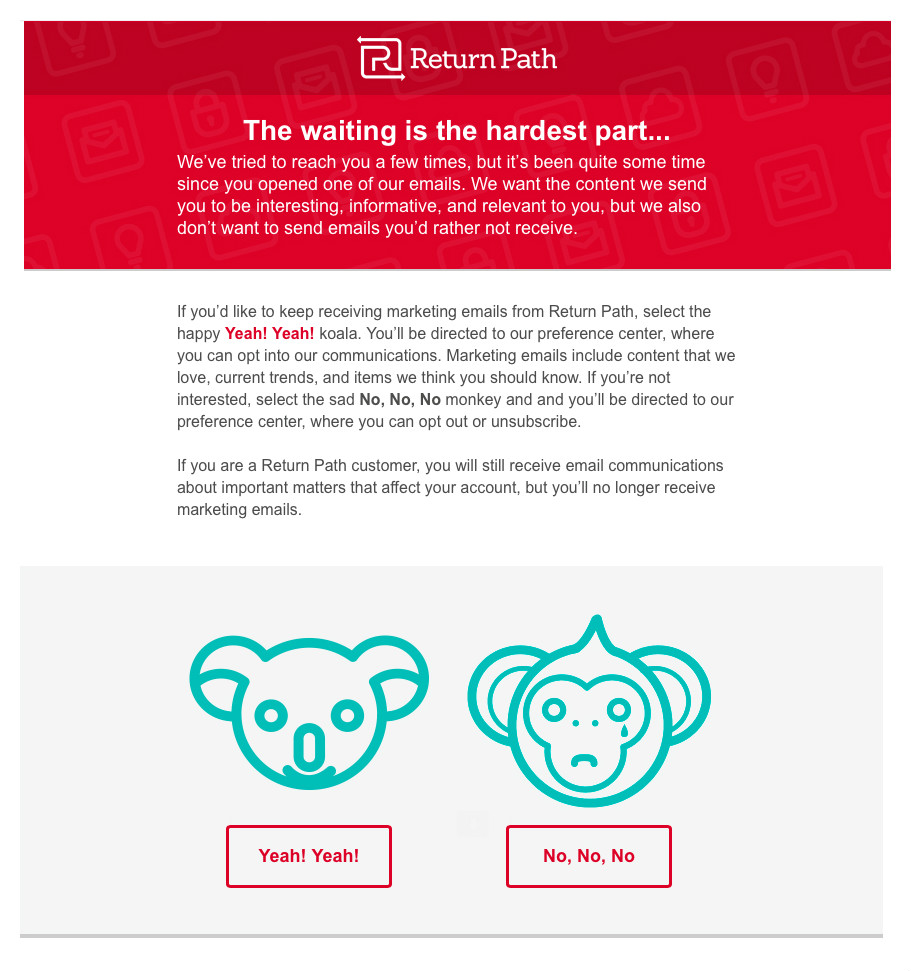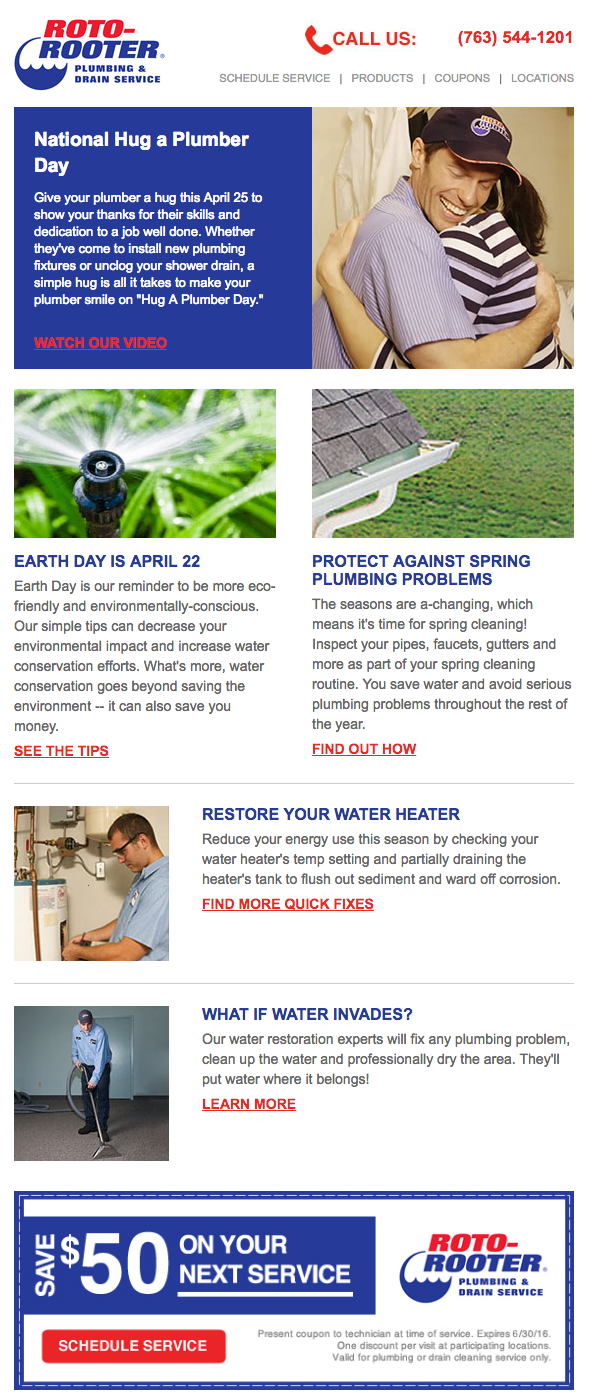Email marketing is like a good marriage. Every once in a while you have to do something out of the ordinary to keep the spice alive, right?
Email mail marketing is similar. As more and more businesses turn to email marketing to promote and sell their product or service, there’s increased likelihood of falling into a rut. In time, your emails start to sound the same or you promote the same sales year after year.
To spice up your email marketing, we’ve found five email tactics that other companies are using that you can learn from.

Company you learn from: Return Path, a data solutions company
Action you can mimic: Send an email intended to remove or re-engage inactive customers
Have you looked at your contact list and wondered, “When should I start removing inactive members?”
It’s a tough call, but inactive members are dead weight to a highly functioning email list. You don’t want to keep them around too long. The rule of thumb for most businesses is to remove contacts that are dormant for a year. In other words, if a contact doesn’t open an email or engage with your business for 12 month, it’s time to cut the cord.
Having said that, some businesses send an email to inactive members to make sure they’re no longer interested in receiving their messages. Return Path, a data solutions company, does that with the email below:
Notice the email takes a friendly tone, and points out that the subscriber hasn’t opened any emails or clicked in some time.
It offers two calls to action. One is the “Yeah! Yeah!” button, which Return Path obviously prefers and the other call to action says, “No, No, No.”
The email is a great way to gauge whether or not a subscriber is still interested in your message, and provides a guilt-free way for you to remove subscribers from the list if they opt out.
Company you learn from: Star Tribune, a Minnesota-based newspaper
Action you can mimic: Create partnership offers to bring customers back
Every business works to attract and retain customers, and many focus most of their efforts on getting new customers in the door. However, research suggests focusing on customer retention is a better investment. It costs a business seven times more to acquire a customer, than it does to retain one that’s already shopped with you.
That’s not to say that customer acquisition isn’t important, it just shouldn’t outshine retention efforts.
So, what kind of customer retention strategies can you deploy? A Minnesota-based newspaper has a great idea that you can learn from.
The Star Tribune teamed up with the Minnesota Park System to offer a special incentive to subscribers that are ready to renew their subscription. Every subscriber that decides to renew his or her newspaper membership gets a free yearlong park pass.
The email does a great job of highlighting the deal, and spelling out the variety of subscription packages that are available. Plus, the email explains the value of the park pass in monetary terms – it’s a $25 item – so subscribers instantly know they’re getting a good deal.
The Star Tribune’s partnership is a great way to add value to a subscriber’s membership, while enticing Minnesotans to renew their commitment to the paper.
Is there a partnership that your business can enter to do something similar? Consider teaming up with a neighboring business, or even a nonprofit that customers relate to. Both sides can create a mutually beneficial offer, and both businesses can send it to their list of subscribers. A win-win.
Company you learn from: Roto-Rooter, plumbing company
Action you can mimic: Celebrate random holidays
Businesses are great at sending emails to promote traditional holiday sales. From birthdays to Christmas, you’ve probably got the popular gift-giving emails set and ready to go each year.
Where businesses tend to skimp is on the nontraditional holidays. There are hundreds of out-of-the-box holidays that businesses can use that are relevant to their audience.
For instance, did you know about National Hug a Plumber Day? Yup, it exists, and Roto-Rooter decided to capitalize on it. As part of their regular newsletter, Roto-Rooter included an article about the holiday and gave a shout out to all of their skilled employees. Take a look:
Cool idea, right? You can do the same thing. Here’s a list of bizarre holidays that you can use for your business.
Consider creating a sale around the holiday and invite customers to it through email, or email a coupon that’s connected to the holiday.
These holidays are already a little zany, so feel free to be creative with your email.
These nontraditional holidays are a great excuse to reach out to customers during a slow time too. When you know sales will slump a bit, check the holiday calendar and create a few emails that will encourage customers to come in.

Company you learn from: Cook Smarts, a meal-planning site
Action you can mimic: Unique drip campaigns
Is your business using drip campaigns? A drip campaign is a series of emails that are automatically sent to subscribers based on a triggered event.
For example, let’s say you have an event coming up. You can create a drip campaign around it. The first email is an invitation that goes out on specific date, which is the trigger. The next email offers subscribers more information about the event, like who the guest speaker is and dress code information. Only the subscribers that opened your first email will receive the second email, that’s the trigger.
Drip campaigns are one of the best ways to nurture leads, with open rates about 80% higher than single sends, and yet, many businesses don’t use them.
Cook Smarts has created a unique drip campaign that you can learn from. The company sends out weekly meal plans, like this:
Every week a new plan is emailed. In addition, emails can be dripped that coincide with the plans. If a subscriber clicks on one of the videos, for example, an email with the recipe can be dripped.
Think of unique ways to send drip campaigns that apply to your company. If you run a fitness company, consider creating a month long workout routine. Subscribers can sign up and get a daily workout schedule sent to their inbox. You can offer cooking classes presented via email, or makeup tips for the holidays with how-to pictures.
Whatever product or service your business offers, come up with a way to offer tips or classes around them. Use email to deliver each tip or class.
Pinpointe users can create drip campaigns using these simple steps.
Nonprofit you learn from: Red Cross, a nonprofit that provides care to those in need
Action you can mimic: Strategically place your email sign up form
Ok, this example breaks the rules a bit. It’s a lesson you can learn from a nonprofit, not a company, but it’s worth pointing out.
The American Red Cross is a well-known profit. It provides assistance to a variety of people in need, which requires a lot of volunteers and fundraising. What’s one of the most affordable ways to keep in touch with volunteers, donors and supporters? Email.
To make sure the Red Cross can stay connected with its core audience, the nonprofit decided to put an email sign up form on its website. Now, a lot of businesses have a sign up form on their website, so you’re probably wondering what makes the form on the Red Cross site different? The answer: placement.
Here’s a screenshot of their website:
Notice the sign up form has a prominent place on the main page, that’s “above the fold.” In other words, visitors don’t have to scroll down to find the sign up box. A lot of businesses add the form to the very end of a site, which doesn’t provide the same presence.
Visitors can’t miss this sign up box, and its strategic placement is something businesses can learn from.
Don’t have a sign up form on your website yet? Pinpointe users can create a website sign up form in a snap, here are the instructions.
Wrap up
Email marketing is a great tool for businesses, but it’s important to make sure that the content is fresh and that you’re reaching out to your customers for a variety of reasons.
When you’re in need of a little inspiration, try flipping through you own inbox and see what other businesses are doing. If an email catches your eye, flag it and use it to inspire an email for your business.
You can also cruise through a site, Really Good Emails. It’s an archive of emails that are broken into different categories. Check it out for additional ideas.
[Tweet “5 Email Tactics That Other Companies Use That You Can Learn From “]











